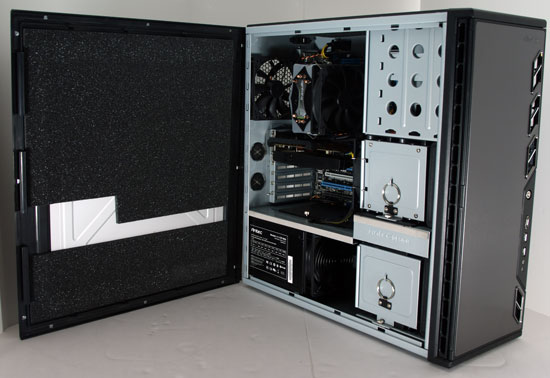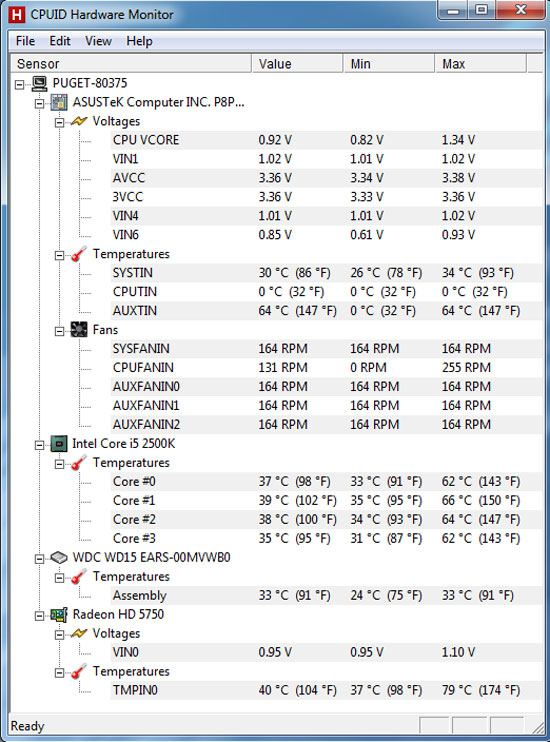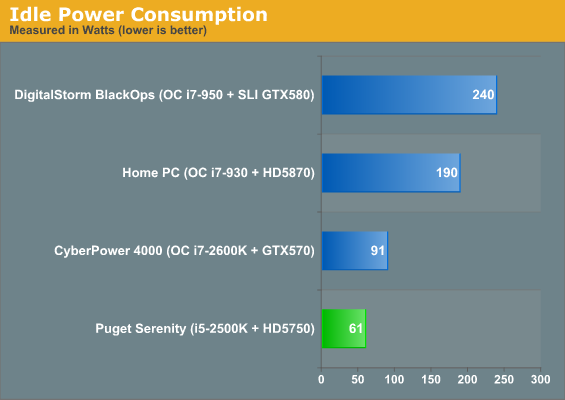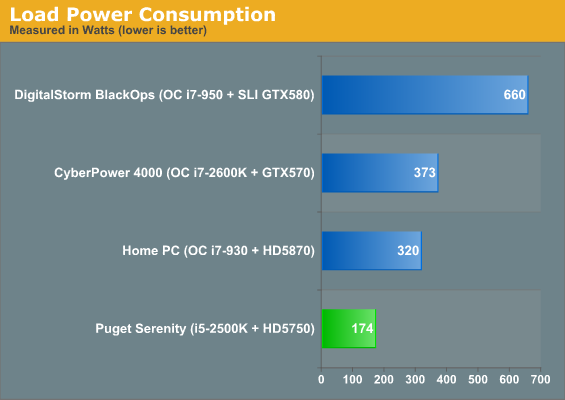Puget Systems Serenity SPCR Edition: Blissful Silence
by Dustin Sklavos on February 10, 2011 12:00 AM EST- Posted in
- Systems
- Intel
- Radeon
- Sandy Bridge
- Puget Systems
- Serenity SPCR
Build, Noise, Heat, and Power Consumption
Given the somewhat exotic nature of Puget Systems's Serenity SPCR Edition tower, it's reasonable to assume that there just aren't any good corners to cut. I'm happy to report that, having examined the system, Puget Systems simply couldn't and didn't.
What makes the build particularly interesting compared to the others is that, as I mentioned in the introduction, this really is a custom build, not just a melange of carefully chosen and assembled parts. Take a look inside and see what I mean.

Seeing the additional foam padding on the inside of the side panel when I had to remove the internal packing was a major cue, and the foam has been carefully cut to fit around the internals of the Antec P183 case used for the build. From the photo you can see three major points in Puget Systems's favor: quality case, quality power supply, and additional custom sound dampening. What's harder to see is that Puget Systems removed the Antec Tricool fans from the case and replaced them with silent Scythe 120mm fans. They've also bracketed an additional fan to the top hard drive tray, and they've removed the top exhaust fan and covered the vent with foam.
Another interesting point is the use of an air cooler instead of a watercooling system on the processor. I've reviewed more desktops with watercoolers than not and they're generally considered among the quietest ways to go, but here Puget Systems opts to use an air cooler—the Gelid Tranquilo—with a silent fan. They also carefully tuned the fan speeds in the ASUS board's UEFI to ensure silent running.
Certainly building the entire system for low noise is going to mean running a little hotter than normal, though, right? Interestingly, that's not the case.

Check out those thermals. The Serenity SPCR Edition keeps everything running remarkably frosty, and that's due in no small part to the attention paid to airflow inside the case. The P183 was already an excellent case with great thermals (we actually have a review unit on hand and we'll be posting a case review in the coming months), but the modified cooling produces airflow moving in effectively a straight line through the tower with minimal turbulence, allowing the fans to run at low speeds without compromising thermal performance. Even the Radeon doesn't crack 80C.
With those temperatures and the system's configuration in mind, these power consumption figures should come as no surprise to you:


We tested power consumption by idling at the desktop, and then running our Left 4 Dead 2 timedemo. In my experience, very few games are capable of pulling as much power from a system as Left 4 Dead 2 can. Something about the Source engine's relatively frugal usage of graphics hardware lets the processor and video power consumption scale well together.
Under load, Puget Systems's Serenity SPCR Edition draws less power than my fairly frugal desktop does at idle. Sandy Bridge has proven to be stunningly power efficient in the testing we've been able to do (we really can't wait to get our hands on more Sandy Bridge-equipped notebooks), and combining that with the already efficient Radeon HD 5750 keeps power consumption low. The next system up on the list—my home tower—draws nearly twice as much power under load. That increase in power draw may be commensurate with the increase in gaming performance, but keep in mind the i5-2500K is able to handle processor-intensive tasks much more efficiently than the i7-930.
















139 Comments
View All Comments
MattM_Super - Thursday, February 10, 2011 - link
I would love an article that focused on building a quiet powerful gaming rig. Some info about DIY sound insulation and how it affects noise and thermals in the case would be great. A guide to building a quiet water cooling system would also be nice. In all the reviews I have read, box kit water coolers end up being louder than high end air coolers.KayDat - Thursday, February 10, 2011 - link
You could check out SPCR (silentpcreview.com), the guys who Puget worked with to build this system. They've been around for ages, lots of info there. The founder, Mike Chin actually took part in the design of the original Antec P180, (arguably) kick starting the whole silent/quiet computing in the commercial market.piroroadkill - Thursday, February 10, 2011 - link
I doubt water cooling is the way to get the absolute quietest type of system.You're always having to run a pump, and no matter how you hide it away, it's still essentially quite a large and powerful rotational mass compared to a fan.
I bet this system is quieter than anything you could build with water cooling.
PartEleven - Thursday, February 10, 2011 - link
Air cooling is the absolute quietest solution. Water cooling has the benefit of a lower sound-to-cooling power ratio as you scale up, but if you're talking about the absolute lowest noise possible, air cooling wins. It's why Puget went with air cooling in this system. Piroroadkill was right: with water cooling there's always going to be a pump. While they may be quiet, I've never encountered one as quiet as properly tuned fans.Martin Schou - Thursday, February 10, 2011 - link
"If you're a little bit underwhelmed by the Radeon HD 5750 in our review unit, don't be. This 5750 is arguably the fastest passively-cooled card on the market (only the Sparkle GTS 450 really competes)"And what happened to Gigabyte's Radeon HD 5770 Silent Cell, that made it slower than a 5750? I was going to use it in my own HTPC/mid range gaming PC, but it's a bit on the large side and wouldn't fit in my case (height wise)
Dustin Sklavos - Thursday, February 10, 2011 - link
I couldn't find it for purchase. NewEgg only lists the Powercolor 5750 and Sparkle GTS 450. In fact a visit just now to Google Shopping reveals exactly one vendor selling the Silent Cell 5770, across the pond.ganjha - Thursday, February 10, 2011 - link
Gigabyte's Radeon HD 5770 Silent cell has reached EOL I've been told by distributors in my country. It's a shame since I used it in quite a few silent builds, and the cards meant to replace it all use the Windforce 2X/3X cooling.Martin Schou - Thursday, February 10, 2011 - link
Ahh. That explains it. I bought mine in Sweden in late January (2011), and it didn't seem like an issue, but that could just be left over stock; however when I just checked there are about 30 stores that claims to have them in stock.Rather odd though - usually we're the ones being left out, not the US.
DanNeely - Thursday, February 10, 2011 - link
For something that's EOL stores listing it as being in stock might not mean anything. I tried getting a case a few years ago after the non-window version went EOL. About a dozen vendors claimed to have it in stock, but after a few days refunded my money saying their distributer couldn't find it (one took about 3 weeks and a dispute filed with my CC company); about a month after that only half of them removed the case from their list of available parts.Taft12 - Thursday, February 10, 2011 - link
Many vendors (most in fact) will just copy and paste their distributors lists onto their website and wait for the orders to roll in. They spend little effort maintaining their site when distributors run out of stock. It is par for the course in this business and unless you can confirm ACTUAL stock from one or more other vendors, don't bother placing the order. Call them first at least!